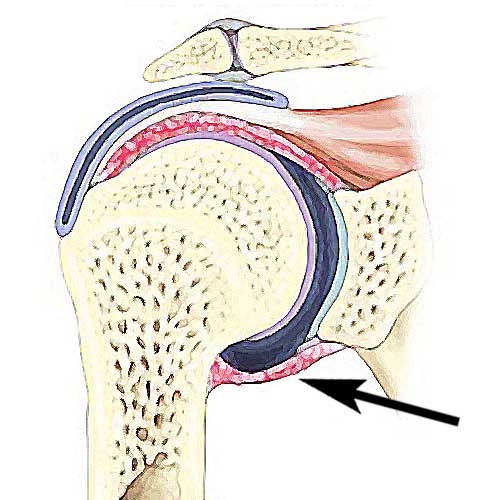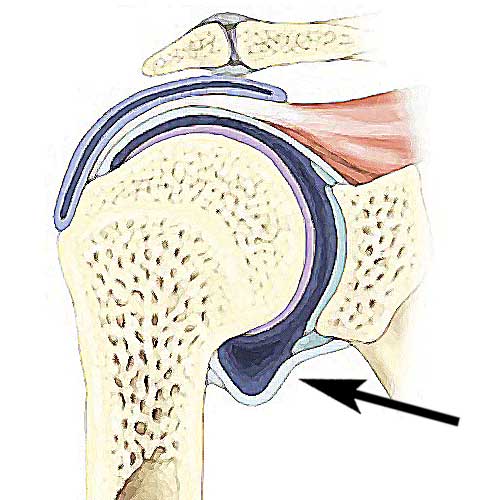
What is Frozen Shoulder?
Frozen shoulder, also known as adhesive capsulitis, is a condition characterised by pain, stiffness, and reduced range of motion in the shoulder joint. It typically develops gradually over time and progresses through three distinct phases: freezing, frozen, and thawing.
The exact cause of frozen shoulder is not fully understood, but it is thought to occur due to the thickening and tightening of the capsule surrounding the shoulder joint. This can lead to the formation of adhesions or scar tissue, which restricts movement and causes pain.
Risk factors for developing frozen shoulder include:
Age and gender
It most commonly affects people between the ages of 40 and 60, and women are more prone to developing frozen shoulder than men.
Immobilisation or reduced shoulder movement
Shoulder injury, surgery, or conditions that limit shoulder movement (such as a rotator cuff tear) can contribute to the development of frozen shoulder.
Systemic diseases
Certain medical conditions, such as diabetes, cardiovascular disease, thyroid disorders, and autoimmune conditions, have been associated with an increased risk of frozen shoulder.

Normal Shoulder
In a normal shoulder, the joint capsule (arrow) is large enough to allow full range of motion.

Frozen Shoulder
In a frozen shoulder, the joint space (arrow) is tightened, leading to joint pain and stiffness.
Frozen Shoulder Treatment
Treatment for frozen shoulder focuses on relieving pain, restoring range of motion, and improving shoulder function. It typically involves a combination of:
Pain management
Nonsteroidal anti-inflammatory drugs (NSAIDs) or corticosteroid injections to reduce pain and inflammation.
Physical therapy
Gentle stretching exercises, range of motion exercises, and specific shoulder exercises to improve flexibility and strength.
Heat or cold therapy
Applying heat or cold packs to the shoulder may help alleviate pain and improve mobility.
Manual therapy
Techniques such as joint mobilisation or manipulation performed by a trained healthcare professional may be utilised to help improve shoulder mobility.
In cases where conservative treatments are not effective, arthroscopic surgery or manipulation under anesthesia may be considered to break up adhesions and improve range of motion.

Shoulder Arthroscopy
Stages of Frozen Shoulder
Frozen shoulder usually goes through three stages during the natural course of the condition. Each stage can last between 3-6 months:
Freezing Phase
The freezing phase is characterised by the onset of shoulder pain and gradually increasing stiffness. During this phase, the shoulder becomes progressively more painful, making everyday activities and movements challenging. The pain may be more pronounced at night, disturbing sleep. Shoulder range of motion starts to decrease, particularly with movements such as reaching overhead, reaching behind the back, or across the body. This phase can last several weeks to several months.
Frozen Phase
Once the freezing phase subsides, the frozen phase begins. In this stage, pain may reduce or become localised to specific movements or positions. However, the shoulder stiffness and limited range of motion persist. The shoulder joint becomes significantly restricted, making it difficult to perform daily tasks and activities. This phase can last for several months to a year or more.
Thawing Phase
The thawing phase is the final stage of frozen shoulder. During this phase, the shoulder gradually regains its range of motion and function. The pain lessens , and the stiffness begins to loosen. Shoulder movements become easier, and individuals experience an improvement in their ability to perform activities that were previously difficult or impossible. The duration of the thawing phase varies among individuals and can last several months to years.
For Patients
If you suspect you may have frozen shoulder, it is best to seek expert help. Dr Arthur Turow is an Australian trained shoulder surgeon based in Adelaide. Dr Arthur Turow can help you with your shoulder pain, provide a proper diagnosis and recommend appropriate treatment options tailored to your specific needs.
